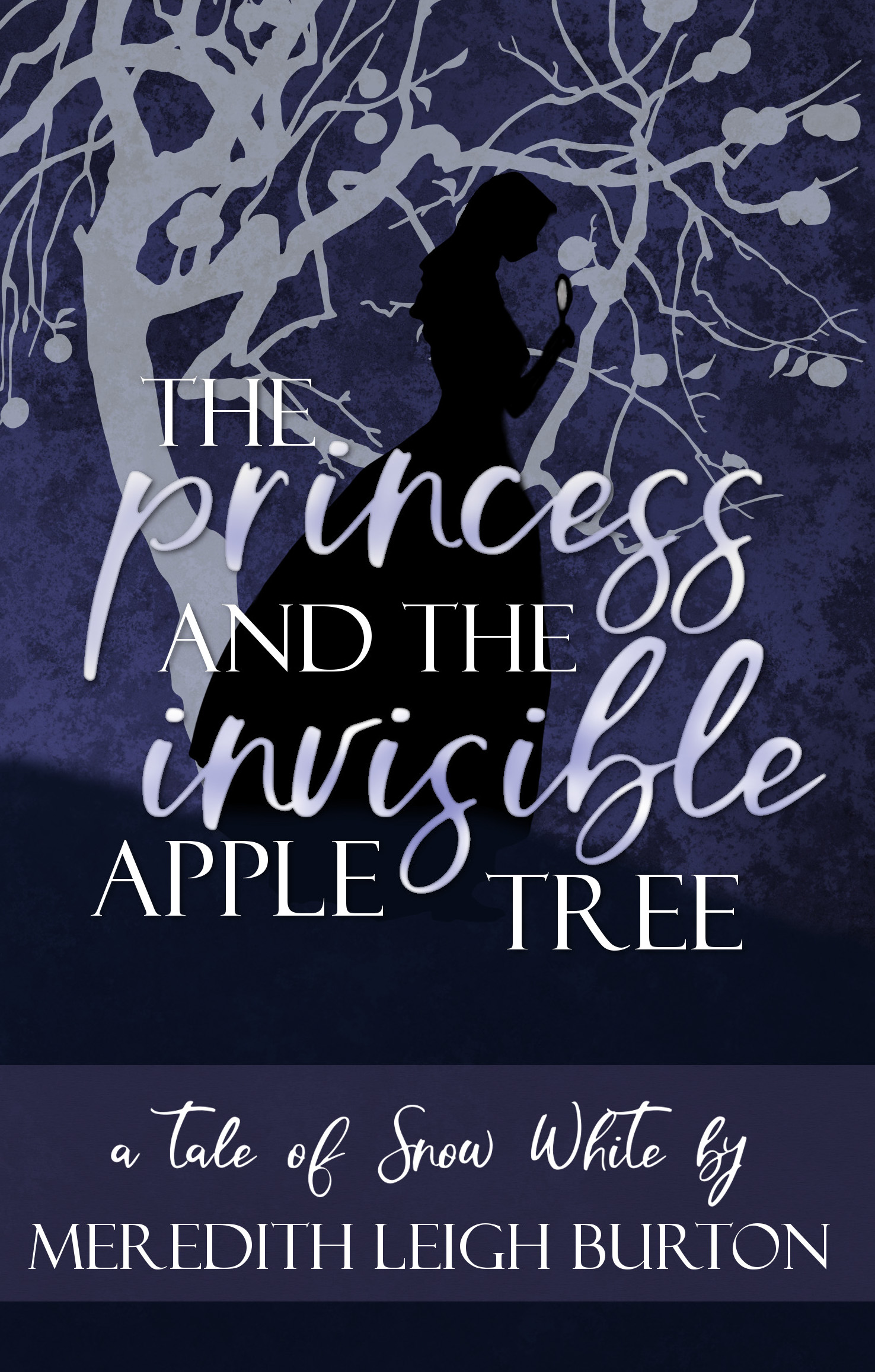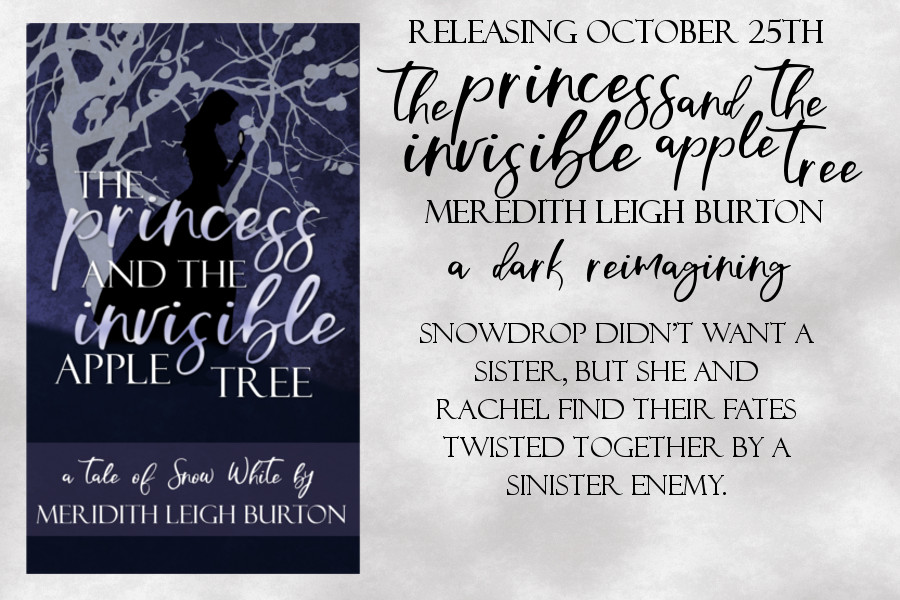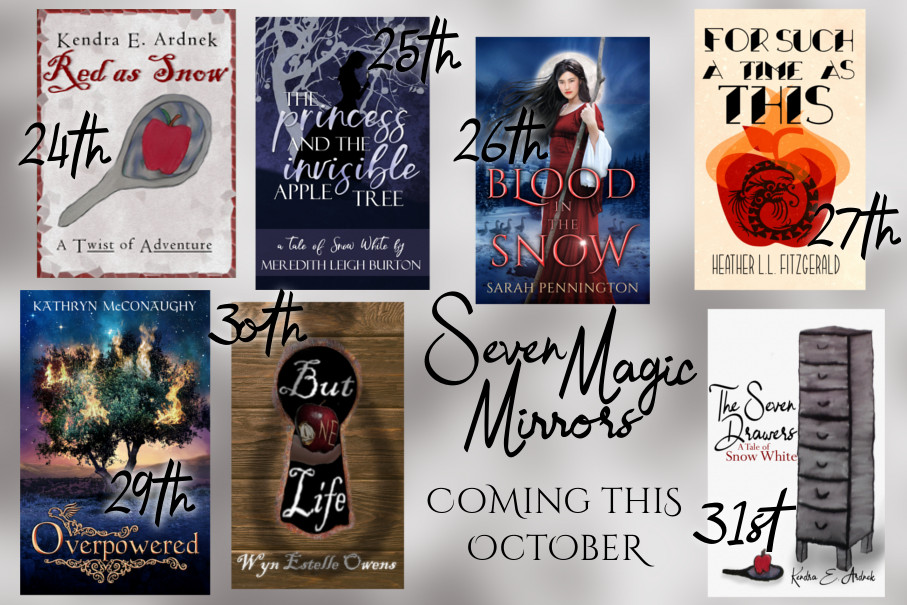Today I am excited to participate in the Magic Mirrors Blog Tour celebrating the release of not one but SEVERAL Snow White Retellings. What are the Magic Mirrors, you ask?
The Magic Mirrors are seven retellings of Snow White and the Seven Dwarfs by six different authors, each unique in tone, setting, and moral. From the light hearted and twisted to dark reimagining to futuristic mashups to non-magical historical fiction, this collection has something in it for every reader.
There is a US Only giveaway you can enter HERE.
My post today is about a dear friend of mine, Meredith Leigh Burton, and her dark retelling, The Princess and the Invisible Apple Tree.
The Princess and the Invisible Apple Tree
Book Description:
 Princess Snowdrop didn’t mean to kill her mother. And now, no one will believe her story about the mysterious peddler who gave her the poisoned pastry. She’s desperate to uncover the man’s identity, but no one else remembers seeing a stranger at the palace on that fateful day or hearing his melodic voice.
Princess Snowdrop didn’t mean to kill her mother. And now, no one will believe her story about the mysterious peddler who gave her the poisoned pastry. She’s desperate to uncover the man’s identity, but no one else remembers seeing a stranger at the palace on that fateful day or hearing his melodic voice.
When Snowdrop’s father goes on a journey in pursuit of answers, he returns newly married. Now Snowdrop must contend with her new stepmother and a stepsister. Rachel is a lonely, soft spoken girl who harbors a harrowing secret. She also carries a mysterious object close to her heart, a mirror that helps her to survive. Could the mirror have come from the same peddler who ruined Snowdrop’s life? Both Snowdrop and Rachel’s stories converge as dark memories are unearthed. A malevolent pursuer lurks in the shadows, and he will stop at nothing to gain the thing he seeks. Disguises are unmasked, and things are not what they seem. Whom can both girls trust?
With the help of two extraordinary artists, a hart and five swans, Snowdrop will discover that courage and sacrifice will be needed if she is to save her stepsister and herself. The Princess and the Invisible Apple Tree is a story where secrets abound, and the path to freedom is not easily obtained.
Now I am going to turn the floor over to Meredith to talk about herself and her writing a little bit.
WHY I WRITE FAIRY TALE RETELLINGS
I have always been drawn to fairy tales; those often belittled but secretly loved stories that praise goodness and mete out justice. Fairy tales speak to everyone’s heart, even those who claim they are only for children. The original fairy tales were never intended for children anyhow. They are stories that, in their original forms, contain gruesome imagery and harsh punishments for the evildoers. An impostor bride is placed in a nail-studded barrel and rolled down a hill to her doom in a lake. An ogress is boiled in oil. Two stepsisters’ feet are mutilated and their eyes pecked out by vengeful birds. An evil queen must dance herself to death in molten hot shoes. I could go on and on. The point of fairy tales is to illustrate that evil will ultimately be vanquished, that love will prevail and justice will be served. But at what a price? The greatest fairy tales contain sacrifice. There is always a cost in the greatest of stories. Someone who seeks to do good will not prevail unscathed. As Jason Shehan says, “Good fairy tales balance sweetness and nightmares. They are candy apples with razor blades inside; kisses touched with poison. … The good ones understand that scars are the best teachers” (NPR Review for The Language of Thorns: Midnight Tales and Dangerous Magic, by Leigh Bardugo).
I enjoy the darker stories, but I also love happy endings. Fairy tales have both these aspects. While I do not mind the occasional tragic ending, I always find myself seeking reassurance from these universal stories. “Snow White,” in particular, is a story with great darkness. The stepmother is a cannibalistic witch wanting to eat Snow White’s lungs and liver in order that she might remain the most beautiful of all. This story has a truly psychopathic personality, one who will stop at nothing to gain what she seeks. Yet at the same time, the story contains beautiful imagery. “Snow White” is the most descriptive of the Grimms collected stories. The descriptions of dazzling red, white, yellow and green symbols are mesmerizing. I love how, when Snow White is encased in her crystal coffin, a white owl perches nearby and watches over her. The imagery of holiness, of knowing that a rescuer is coming, is beautiful. While modern interpretations of the story make the prince a villain, I prefer the more classical representation. However, in my two retellings of “Snow White,” I focus on the way that evil camouflages itself. The story is really an exploration of false perceptions and lost innocence. No matter which way you spin “Snow White,” it is ultimately a story of evil being vanquished and good prevailing.
I write fairy tales because I want to show that the world is striving to be a better place. It is a sin-ravaged world, but God promises it will be restored. The Bible speaks of the world being laid bare and made new. Aren’t fairy tales a feeble reflection of this truth? Evil will fall, and good will rise like a phoenix from the ashes. I write fairy tales to contribute my own feeble candle flame of hope. The darkness will scatter and vanish forever, and we will stand victorious in a world more resplendent than any fairy palace.
Meredith Leigh Burton
 Author Bio:
Author Bio:
Meredith Leigh Burton is a voracious devourer of fairy tales. She is a motivational speaker, teacher and writer. She attended the Tennessee School for the Blind and Middle Tennessee State University, where she received a degree in English and theater. Meredith hopes to convey through her writing that people with differences can contribute much to the world. “Snow White” has always been her favorite fairy tale. Meredith has written another fairy tale based on “Snow White” entitled Hart Spring, which can be found in her anthology, Blind Beauty and Other Tales of Redemption. She resides in Lynchburg, Tennessee.
Find her online at: Goodreads || Amazon
If you would like to follow the other blogs in this tour, be sure to visit Kendra’s Blog for the schedule!


Lovely post!